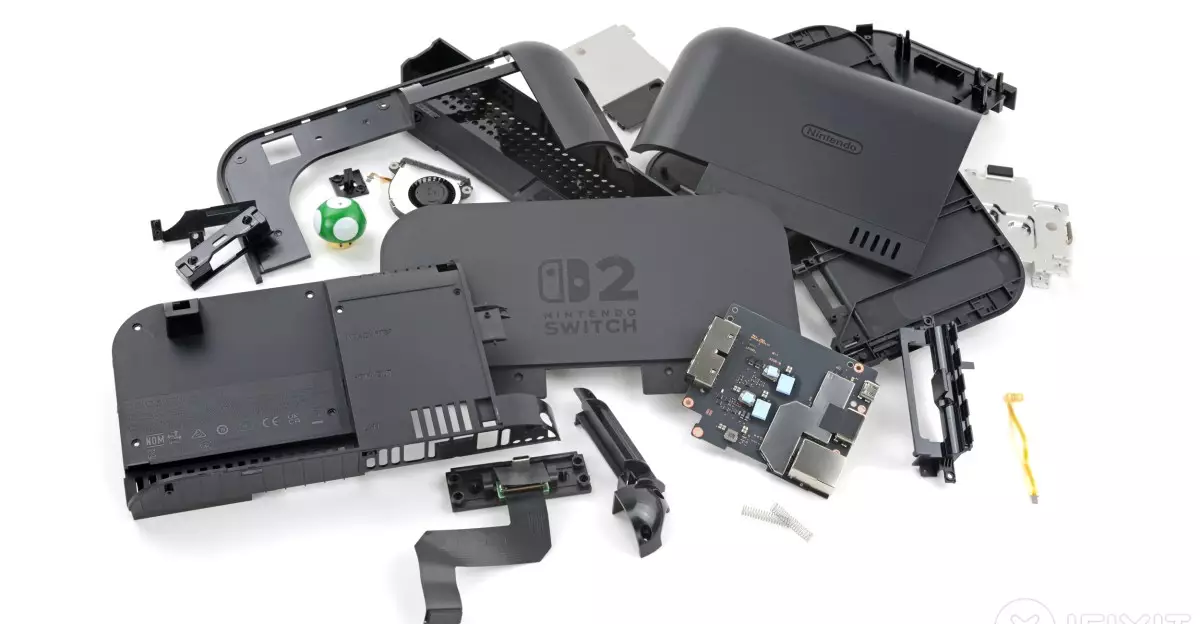Nintendo has always been a company that prioritizes innovative gaming experiences over the technical nuances of their hardware’s repairability. However, the recent teardown analysis of their latest console, the Switch 2, indicates a concerning trend that could frustrate both gamers and repair advocates alike. With a repairability score slashed to a mere 3 out of 10 from its predecessor’s previously inflated score of 4, the latest handheld device reflects a departure from consumer-friendly designs toward a more restrictive framework. This shift speaks volumes about the company’s evolution—or lack thereof—in its approach to sustainability and user autonomy.
The Adhesive Nightmare
One of the most significant issues raised in the teardown by iFixit is the use of potent adhesive for securing the battery. This practice, while effective in creating a durable product, essentially locks users into a world where repairs become a daunting, and sometimes nearly impossible, task. The teardown reported that removing the battery requires an arsenal of isopropyl alcohol and specialized pry tools, all to counteract the adhesive’s steadfast grip. This not only elevates the likelihood of damaging internal components during removal but also raises questions about the long-term sustainability of such practices. Are we, as consumers and tech enthusiasts, becoming too reliant on manufacturers to dictate how we engage with our devices?
Hidden Challenges and Proprietary Practices
The Nintendo Switch 2 features numerous tri-point screws—an established signature of Nintendo’s design ethos—many of which remain obscured behind tamper-proof stickers. This tactic not only makes opening the device a challenge but also poses a risk of permanent damage to the stickers themselves. By hiding screws and relying on proprietary screws, Nintendo enforces a barrier that serves to keep unauthorized repair efforts at bay. Such tactics reflect an outdated mindset that prioritizes corporate control over customer convenience, ultimately undermining the fundamental right to repair and modify our devices.
Soldered Components and Their Implications
Moreover, the decision to solder critical components such as the game card reader and USB-C ports to the mainboard aligns the Switch 2 closer to its more repair-challenged sibling, the Switch Lite. While modularity in design fosters an ethos of accessibility and user empowerment, soldering components together reinforces a fragility that could steer the end-user experience toward frustrating hurdles. Consumers—especially those conscious of the environmental impact of e-waste—are left wondering why the trend seems to skew towards less repairable options, particularly from a company that has historically leaned on imaginative, user-centered designs.
Thermal Paste Anomalies
Even more perplexing is the discovery of three different types of thermal paste used throughout the device. The implications here are twofold: not only does disparate thermal paste contradict foundational principles of efficient heat management, but it further complicates repairs that may require the application of corrective measures down the line. With solidified thermal paste fettering flexibility in maintenance and parts longevity, Nintendo’s design choices seem increasingly at odds with the needs of those who seek longevity over obsolescence.
Joy-Con Design Decisions
Finally, the matter of the newly designed Joy-Cons raises eyebrows. Utilizing the same resistive material as the original, these controllers reintroduce the potential for joystick drift. While the company has not significantly evolved its joystick technology, the added difficulty in repairing the Joy-Cons generates a sense of vigilance among users who have become all too familiar with the frustrations of drift issues. Are gamers now destined to accept joystick failure as an inevitable byproduct of ownership, or will they demand better from a company of Nintendo’s stature?
In essence, the Nintendo Switch 2 poses essential questions about repairability and consumer rights. As more manufacturers pivot towards difficult-to-repair designs, the voices advocating for better accessibility and sustainability in technology must grow louder. Ultimately, whether manufacturers like Nintendo heed these calls remains to be seen, but one thing is clear: The future of gaming hardware hinges on our willingness to advocate for a more inclusive approach.

